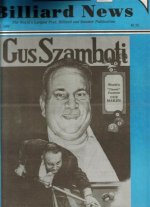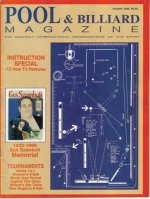Going through some old National Billiard News and I thought this article was really interesting.
Gus Szamboti passes
By Tom Enfield - Philadelphia Inquirer, Tuesday Sept 6 1988
Gus Szamboti was known the world over for the slender beautifully shaped and perfectly balanced wooden sticks that he fashioned in the basement of his Bucks County home.
He made pool cues - "The best you can buy," said Gloria Walker of Exton, a former national and world champion in the games of eight ball and nine ball.
Similar comments were made in poolrooms all over yesterday as word spread that Mr. Szamboti, 56, had suffered a heart attack and died at his home in Penndel. His son Barry said Mr. Szamboti had been home only five days after being released from Temple University Hospital, where he had undergone surgery to replace a heart valve.
More than 200 pool shooters were at the Boulevard Social and Athletic Club in Northeast Philadelphia when the news of Szamboti's death got around about 7 p.m. Sunday.
"Some fellas cried, that's right," said Dawn Strahle, the counter person.
A beefy man, who never managed to quit cigarettes and who drove a Cadillac with a license plate that said CUES, Mr. Szamboti was a straight shooter as a person.
"He was always caring and never took advantage of anybody," said Walker, the owner of a Szamboti pool cue that she says helped make her a champion.
Many people who never knew Mr. Szamboti knew his cues. And they were works of art.
"There are so many things that are involved in making a good cue stick, and he knew them all - the proper wood to use, the drying, the balance and the tapering," said Walker. "I remember Gus telling me in my particular cue alone there are 212 pieces."
His cues weren't cheap. Mr Szamboti told an interviewer four years ago that the price ranges from $325 to $1,000. Among the owners are Steve Mizerak, a world pocket billiards champ well known for his Miller Lite beer commercials, and several time world champion Ray Martin.
"There are no books on how to do this," Mr. Szamboti once said of making cues.
He had grown up with a stick in hand. As a player, though he was never better than fair.
"I always played pool; I played since I was 8 years old," he said in the 1984 interview, recalling days when he could barely reach the green felt table top at St Ann's Boys Club on Lehigh Avenue in Philadelphia.
As an adult, he lived in Croydon before moving to Penndel about 20 years ago. An Army veteran who attended Pennsylvania State University, he was a design engineer for RCA Corp. for many years before deciding in 1972 that he could earn his living making cues.
Surviving, in addition to his son Barry, are his wife, Elizabeth Strocen Szamboti; two other sons, Anthony and Augustine, Jr; three daughters, Sharon Kruas, Ann and Elizabeth; three grandchildren, and a brother.
Gus Szamboti passes
By Tom Enfield - Philadelphia Inquirer, Tuesday Sept 6 1988
Gus Szamboti was known the world over for the slender beautifully shaped and perfectly balanced wooden sticks that he fashioned in the basement of his Bucks County home.
He made pool cues - "The best you can buy," said Gloria Walker of Exton, a former national and world champion in the games of eight ball and nine ball.
Similar comments were made in poolrooms all over yesterday as word spread that Mr. Szamboti, 56, had suffered a heart attack and died at his home in Penndel. His son Barry said Mr. Szamboti had been home only five days after being released from Temple University Hospital, where he had undergone surgery to replace a heart valve.
More than 200 pool shooters were at the Boulevard Social and Athletic Club in Northeast Philadelphia when the news of Szamboti's death got around about 7 p.m. Sunday.
"Some fellas cried, that's right," said Dawn Strahle, the counter person.
A beefy man, who never managed to quit cigarettes and who drove a Cadillac with a license plate that said CUES, Mr. Szamboti was a straight shooter as a person.
"He was always caring and never took advantage of anybody," said Walker, the owner of a Szamboti pool cue that she says helped make her a champion.
Many people who never knew Mr. Szamboti knew his cues. And they were works of art.
"There are so many things that are involved in making a good cue stick, and he knew them all - the proper wood to use, the drying, the balance and the tapering," said Walker. "I remember Gus telling me in my particular cue alone there are 212 pieces."
His cues weren't cheap. Mr Szamboti told an interviewer four years ago that the price ranges from $325 to $1,000. Among the owners are Steve Mizerak, a world pocket billiards champ well known for his Miller Lite beer commercials, and several time world champion Ray Martin.
"There are no books on how to do this," Mr. Szamboti once said of making cues.
He had grown up with a stick in hand. As a player, though he was never better than fair.
"I always played pool; I played since I was 8 years old," he said in the 1984 interview, recalling days when he could barely reach the green felt table top at St Ann's Boys Club on Lehigh Avenue in Philadelphia.
As an adult, he lived in Croydon before moving to Penndel about 20 years ago. An Army veteran who attended Pennsylvania State University, he was a design engineer for RCA Corp. for many years before deciding in 1972 that he could earn his living making cues.
Surviving, in addition to his son Barry, are his wife, Elizabeth Strocen Szamboti; two other sons, Anthony and Augustine, Jr; three daughters, Sharon Kruas, Ann and Elizabeth; three grandchildren, and a brother.

